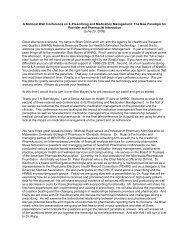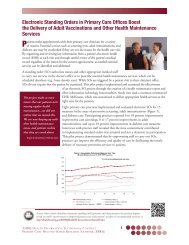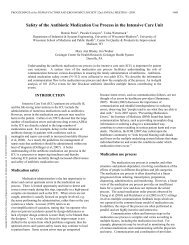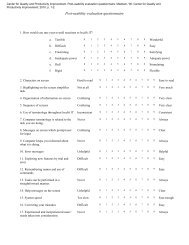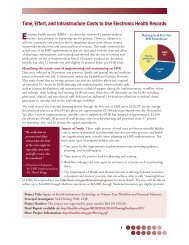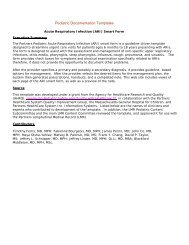Sustainability, Partnership, and Teamwork in Health IT Implementation
Sustainability, Partnership, and Teamwork in Health IT Implementation
Sustainability, Partnership, and Teamwork in Health IT Implementation
Create successful ePaper yourself
Turn your PDF publications into a flip-book with our unique Google optimized e-Paper software.
Figures<br />
Figure ES.1. Reported level of health <strong>IT</strong> use <strong>in</strong> summer 2011, compared with end of<br />
grant period...................................................................................................................................... 4<br />
Figure ES.2. Percentage of implementation grantees where <strong>in</strong>tended users<br />
attended competency-based tra<strong>in</strong><strong>in</strong>g................................................................................................. 7<br />
Figure 2.1. Use of health <strong>IT</strong>—summer 2011 compared with end of grant period........................... 20<br />
Figure 2.2. Reported level of health <strong>IT</strong> use <strong>in</strong> summer 2011, compared with end of<br />
grant period.................................................................................................................................... 21<br />
Figure 2.3. Reasons for susta<strong>in</strong>ed or <strong>in</strong>creased use of health <strong>IT</strong>...................................................... 24<br />
Figure 2.4. Needs <strong>and</strong> support for extended plann<strong>in</strong>g process by plann<strong>in</strong>g grantees....................... 25<br />
Figure 2.5. Comparison of selected implementation features among grantees<br />
that did <strong>and</strong> did not experience a show-stopper.............................................................................. 27<br />
Figure 3.1. Association between strengths of implementation grant projects <strong>and</strong><br />
complet<strong>in</strong>g a thorough vendor-selection process............................................................................. 30<br />
Figure 3.2. Percentage of implementation grantees who undertook steps for vendor selection........ 31<br />
Figure 3.3. Most important factors <strong>in</strong> purchas<strong>in</strong>g a health <strong>IT</strong> product for<br />
implementation grantees................................................................................................................. 32<br />
Figure 4.1. Types of patient care delivery organizations <strong>in</strong>cluded <strong>in</strong> grantee partnerships............... 36<br />
Figure 4.2. Types of hospitals <strong>in</strong>cluded <strong>in</strong> grantee partnerships (n = 488 hospitals)........................ 37<br />
Figure 4.3. Size of private physician practices <strong>in</strong>cluded <strong>in</strong> grantee partnerships<br />
(n = 528 private physician practices)............................................................................................... 37<br />
Figure 4.4. Percentage of grantees whose partnerships <strong>in</strong>cluded organizations<br />
that do not deliver patient care........................................................................................................ 38<br />
Figure 4.5. Cont<strong>in</strong>uation of plann<strong>in</strong>g <strong>and</strong> implementation partnerships after<br />
conclusion of the grant.................................................................................................................... 39<br />
Figure 4.6. Reasons patient care delivery organizations stopped work<strong>in</strong>g together<br />
after the plann<strong>in</strong>g or implementation grant period......................................................................... 40<br />
Figure 4.7. Association between strengths of plann<strong>in</strong>g <strong>and</strong> private physician <strong>in</strong>volvement<br />
for plann<strong>in</strong>g <strong>and</strong> implementation grantees (comb<strong>in</strong>ed)................................................................... 43<br />
Figure 5.1. Encourag<strong>in</strong>g tra<strong>in</strong><strong>in</strong>g of all targeted end users.............................................................. 48<br />
Figure 5.2. Percentage of implementation grantees that had users attend<br />
competency-based tra<strong>in</strong><strong>in</strong>g............................................................................................................. 49<br />
Figure 5.3. Tra<strong>in</strong><strong>in</strong>g super users <strong>and</strong> champions early..................................................................... 50<br />
Figure 5.4. Tim<strong>in</strong>g of tra<strong>in</strong><strong>in</strong>g relative to go-live............................................................................ 51<br />
Figure 5.5. Percentage of grantees with formal <strong>and</strong> <strong>in</strong>formal process redesign (n = 41)................... 52<br />
vi<br />
Contents



